
Courtesy of the Fort

Audio By Carbonatix
I’m often asked for restaurant recommendations, and when the person asking is from out of state, they usually want to know where to eat for a taste of “Colorado food.” But what exactly does that mean?
We posed the question to a wide range of local food pros. Here’s what they had to say:
How would you define Colorado cuisine?
Paul C. Reilly, culinary director/proprietor, Coperta: Emerging. Not yet set in stone.
Denver, make your New Year’s Resolution Count!
We’re $17,500 away from our End-of-Year campaign goal, with just a five days left! We’re ready to deliver — but we need the resources to do it right. If Westword matters to you, please contribute today to help us expand our current events coverage when it’s needed most.
Bo Porytko, chef/owner, Molotov: We went from a meat-and-potatoes city to a heritage-meat-and-heirloom-potatoes city. I think that Denver cuisine is still a little cautious, but we (both diners and chefs) care a lot about where we source our food and try to use the exceptional product that is available to us here locally in Colorado. We firmly believe in farm-to-table (even when that term has kind of fallen out of favor).
Jesus Silva, chef, Tacos al Chile, Republik of Chicken and Sushi Sora at the Golden Mill: The food culture feels like an evolving force building toward its destination. We now can celebrate so many Michelin-starred restaurants, and I can look across the landscape and see so many talented chefs up and down the rosters. This is an exciting time.
Aniedra Nichols, chef/co-owner, Table 6: Local, seasonal, thoughtful.
Mark Antonation, former Westword food and drink editor: Colorado cuisine is defined by our short growing season, sunny days, cool nights and small but distinct growing regions. We eat what grows well here in the summer and what can be stored or preserved to make hearty meals in the winter.
Robert Guillory, CEO/co-owner, Southern Bell Catering Group: Colorado cuisine, while often associated with Western-inspired fare, is a diverse tapestry influenced by various factors, including Native American traditions, Mexican cuisine and European settlers. It blends hearty, comforting flavors with fresh, local ingredients, reflecting the state’s natural beauty and agricultural bounty.
Jeff Osaka, chef/owner, Sushi-Rama and Osaka Ramen: To me, it’s hard to define what Colorado cuisine is because it’s evolved so much in the sixteen years I’ve lived here. In part, that there are so many producers popping up when I never knew they existed. Potato and grain farmers, local honey, sunflower and canola for cooking oil production, and so much more!
Donovan Davis, executive chef, the Common Good: Colorado’s cuisine is ever-evolving, in my opinion. With the influx of people from all over the country and all over the world, we have many different styles of food, and many different styles of cuisine. Colorado, of course, has its own long-lasting dishes and local ingredients that will always stand out.
Ricardo Villalobos, executive chef, My Neighbor Felix: Colorado’s cuisine is a vibrant tapestry woven from the diverse cultures that call the state home, with a particularly strong influence from Mexican culture. I love exploring the different culinary styles available here, and I’m consistently impressed by the freshness, local sourcing and bold flavors that characterize the food. Each dish tells a story, reflecting the rich heritage and creativity of the state’s culinary scene.
Kyle Mendenhall, senior director of culinary innovation, Snooze A.M. Eatery: Colorado cuisine is clearly pretty diverse. It’s a little cowboy, a little Native American, a little Southwestern, some West Coast and a little Midwest. Although, it’s still none of those, exactly…

Corn is often on the menu at Señor Bear.
Connor Stehr
Joe Mazzocco, executive chef, Señor Bear: I think of its diverse influences and emphasis on local ingredients, reflecting the state’s agricultural heritage and natural resources. The farm-to-table philosophy plays a big role for us at Señor Bear, as we source ingredients from local farms and try to focus on freshness and sustainability. We also pull a lot of influence and inspiration from various cultures and tend to blend Native American, Mexican and Western influences, which often result in unique twists on traditional dishes.
Sheila Lucero, executive chef, Jax Fish House and Centro Mexican Kitchen: I am a Colorado native, and I have seen quite an evolution in the state’s cuisine. Colorado cuisine reflects our cultural history, diverse landscape and local ingredients. Influenced by Native American, Mexican and Western ranching traditions, our cuisine often emphasizes bold, hearty flavors with a focus on game meats like bison, elk and lamb. Fresh, farm-to-table produce plays a big part, with ingredients like Palisade peaches, Olathe sweet corn, Pueblo chiles and Rocky Mountain trout. The chef community in Colorado is passionate about sustainability and locally sourced ingredients. I think better accessibility to great products from all over the state has helped consumers and chefs represent, utilize and enjoy all the greatness Colorado has to offer. 
Corey Ferguson, executive chef, El Five: For me, being born and raised in Colorado, our cuisine is shaped by our place, our history and the people who call Colorado home. Hunting, fishing, farming and ranching was always a part of my life. That shaped Colorado cuisine for me. Antelope sausage, brook trout cooked in the coals of a campfire, a trip to the Fort for a pioneer’s dinner and, of course, all the wonderful produce from Colorado. Colorado is an agricultural state, and that has certainly helped define Colorado cuisine, as well as a healthy influence from Midwestern and Southwestern cuisine.
Matt Vawter, chef/owner, Rootstalk: As a native Coloradan, narrowing us down to one specific type of cuisine is a bit tough, but this just means we’re still defining our culinary identity, which makes it exciting for us chefs. Given the number of people who have moved here from all over the country (and the world), it’s become a bit of a melting pot, blending influences from Mexican and Southwestern cuisine, as well as the Midwest, the South and the West Coast.
Holly Kinney, proprietress, the Fort: Colorado cuisine is indigenous foods that American Indian Nations prepared and that today we celebrate as new foods of the Old West. Bison was the primary protein, grilled or stewed, as was other game such as elk, deer, antelope, quail, trout, etc. For vegetables, corn, beans and squash were the Three Sacred Sisters and, prepared together, they provide a complete vegetarian protein. Tepary and Anasazi beans, piñon nuts, pumpkin seeds, pumpkin squash, and berries such as chokecherry were indigenous to Colorado. Also, chiles – green and red chile has been grown for thousands of years in Colorado. Chocolate was traded into Colorado and New Mexico from the Tlaxcala Mexican Indigenous tribes. The Spanish brought churro sheep, which were used by the Diné for eating and weaving their wool into blankets. Early Spanish settlers also raised sheep and goats. For fruits and vegetables, early settlers planted peach trees, and Colorado has become known for our Palisade peaches, Olathe corn and Rocky Ford cantaloupe. Cuisine reflecting Colorado’s indigenous ingredients is key to calling it Colorado cuisine.
Rich Grant, former communications director for Visit Denver: Just as fish and chips are to England, baguettes to France, gyros to Greece and pasta to Italy, Colorado is most closely associated with beef. Denver was the endpoint for one of the great cattle drive trails, but most of them drove cattle north from Texas and ended along the rail lines farther east in Kansas and Nebraska, which became more well known for beef steaks. Colorado (at least “tourist” Colorado), at the base of the Rocky Mountains, became more associated with the exotic meats of the West, buffalo and elk. The National Western Stock Show in Denver for decades was the largest marketplace for beef in the world. Red meat is the longest- and most-associated cuisine with Colorado.
Dana Rodriguez, chef/owner, Carne and Work & Class; culinary partner, Casa Bonita: I don’t necessarily feel there is a clear definition of Colorado cuisine. What I think makes Colorado amazing is the diversity of cultures and cuisines found in our food.
John Imbergamo, president of the Imbergamo Group: I really hate this question. Can anyone define Ohio cuisine? Minnesota cuisine? Other than New Orleans, does any place really have a singular food ethos? Even if one could define it, what does that mean? Should we expect every NOLA restaurant in NOLA to serve po’boys, étouffée and gumbo? Thank you for attending my TED Talk.
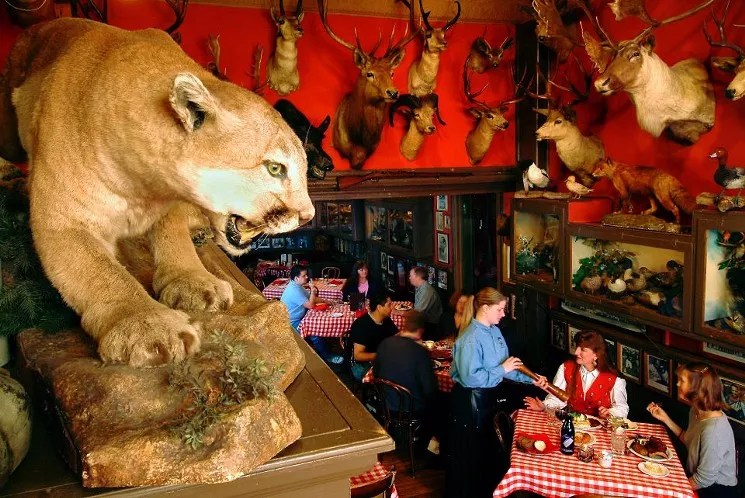
Game meat is a staple at Buckhorn Exchange, but not many newer restaurants.
Photo courtesy of Buckhorn Exchange
What misconceptions are there about Colorado cuisine?
Porytko: That we use a lot of game meat. It’s awesome that some Colorado staples like the Buckhorn Exchange, the Fort and Biker Jim’s (before he got unfairly screwed) make that a part of their culinary narrative, but it’s unfortunate we don’t see more of that. I know it’s more than partially because of the strict rules about where you are allowed to source your game meat. I pine for the days when I would be allowed to buy and prepare some elk from my hunting-buddy friend coming back to Denver with his fresh kill (whose butchery methods I trust implicitly) and not have to worry about the health department shutting me down. We have to buy moose from somewhere like Finland when there’s a perfectly good one waiting for us in Winter Park.
Vawter: Up here in the mountains, visitors often expect abundant local trout and game. While you can find them on various restaurant menus, they’re not coming from local sources. Most of those proteins come from out of the state or even out of the country.
Silva: That we are still a steakhouse restaurant town, or that we can’t get fresh fish like supposedly bigger cities can. We have one of the most badass airports in the world, and if I order fish today from Japan, I can get it tomorrow.
Nichols: All we do is steak or beef because we are a “cowtown.” Because we are landlocked, we don’t get fresh seafood. We’ve been producing great cuisine for decades, and yet we are still not recognized as often as we should be.
Lucero: I believe that we have more to offer than Denver omelets and Rocky Mountain oysters. Both are good, but I think we have so much more to talk about. I also have to be an advocate for fresh seafood in Colorado. The commentary about inland states not being able to get fresh seafood is exhausting to hear. We actually have a wonderful hybrid striped bass that is produced in Alamosa and is super versatile and consistent. 
Guillory: Limited to steak and potatoes: While these are popular, Colorado cuisine offers much more. All Tex-Mex: While there’s a strong Mexican influence, Colorado has its own unique culinary identity. Unrefined or rustic: There’s a growing sophistication in Colorado’s food scene.
Mazzocco: There’s a notion that Colorado cuisine is heavy and indulgent. In some cases this is true, but we are seeing quite the upturn, with many restaurants prioritizing health-conscious and vegetarian/vegan options, reflecting a trend toward healthier eating. While meat is a staple, especially game meats, many Colorado chefs are beginning to focus on plant-based dishes and seasonal vegetables, showcasing a commitment to and listening to what the Colorado food scene is looking for.
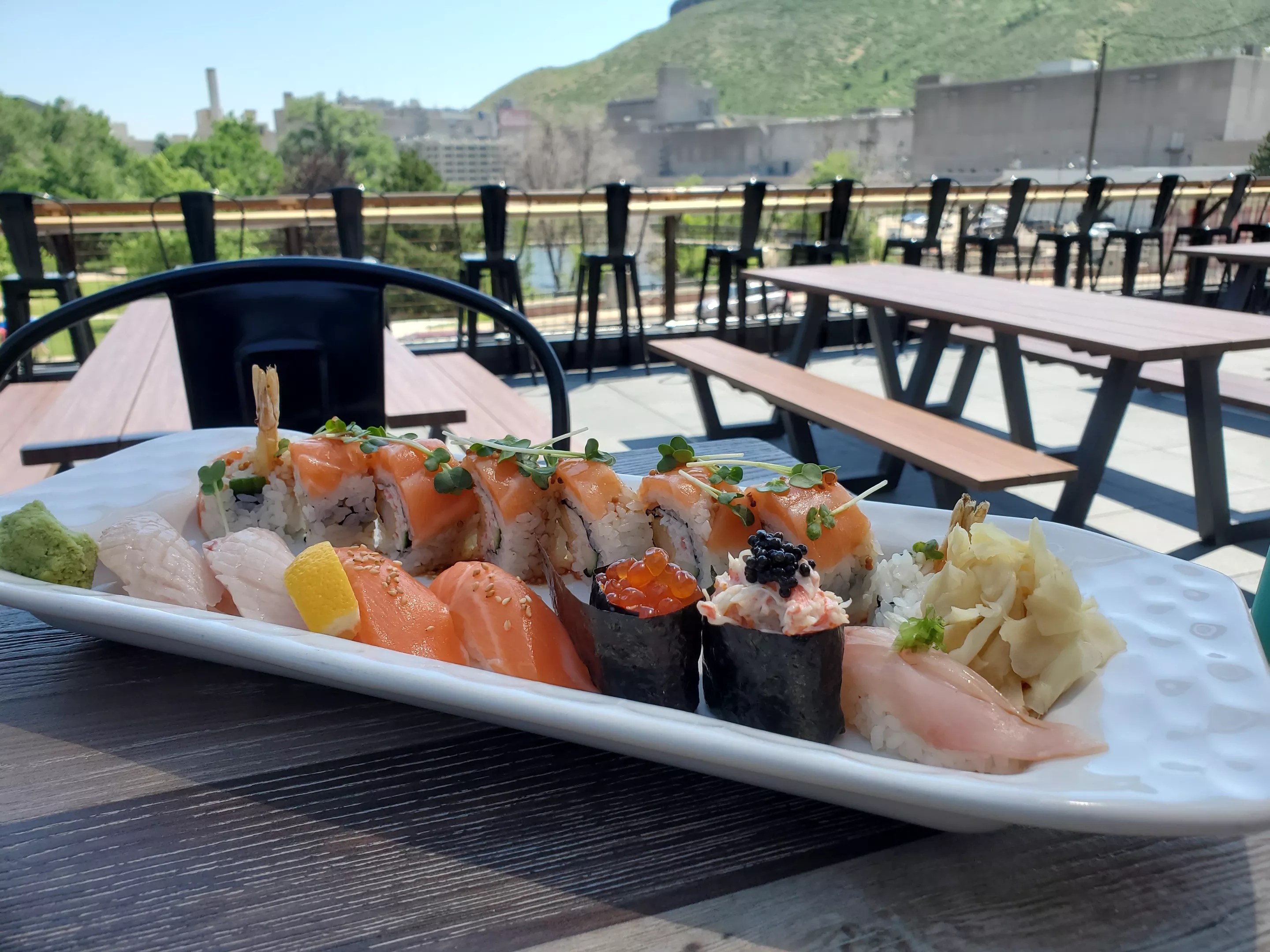
“If I order fish today from Japan, I can get it tomorrow,” says chef Jesus Silva.
Molly Martin
Mendenhall: That it is all beef-forward. That Rocky Mountain oysters are actually good. We also actually do have amazing wines produced on the Western Slope, and we don’t serve as much wild game as the rest of the country thinks.
Villalobos: A common misconception I often encounter about Colorado cuisine, particularly in Denver, is that it lacks freshness. I’ve also heard claims that it lacks regional influences. However, Colorado truly serves as a melting pot, drawing culinary inspiration from everyone who passes through.
Imbergamo: During his many years as spokesperson for Visit Denver, Rich Grant answered this question from every national journalist with the same phrase. “Beer and buffalo,” said Rich, thereby poisoning the national perception of Denver dining forever and doubling down on our “cowtown” culinary reputation. Every visiting journalist was treated to the Wynkoop, Buckhorn Exchange or the Fort after a visit to Rockmount Ranch Wear. Nothing wrong with those restaurants, but they reflected Denver’s chef-driven culinary progress as much as Rockmount represented our everyday sartorial choices.
Grant: Coloradans come from every corner of the earth. In 1858, when gold was discovered along Cherry Creek in what became Denver, there were a handful of Europeans living in what was called the Colorado Territory. In two years, 100,000 men and women crossed the Great Plains, and by 1876, Colorado became a state. People came to Colorado from everywhere. When the railroads arrived, oysters and French Champagne were available in the wildest of Wild West mining towns, along with Chinese restaurants and every type of European cuisine. Colorado was never solely a “cowtown” of beef. All cuisines have always been available since the very beginning. But what was uniquely Coloradan? Well, pork green chile. Different from the rest of the Southwest. And exotic meats of buffalo and elk, which stuck here along with beef while they did not in other parts of the West.
Edgar Drago, executive chef, Wonderyard: The misconception is that Colorado offers a limited cuisine, that we have a small culinary presence with basic flavors that are not fresh or, on the opposite spectrum, that we think must be expensive and exclusive. Restaurants that limit flavor, prepare arrogant food and confuse it with elegance. I think we, as a culinary community, incorporate value, fresh ingredients and presentation all in one. Colorado cuisine is rich in flavor and overall has soul. We have evolved, as proven by how many independently owned restaurants from Colorado chefs we have now compared to fifteen years ago.
Sujie Kim, director of marketing for Mile High Asian Food Week: A huge misconception about Colorado cuisine is that we don’t have a variety of Asian cuisines, let alone good options. Even if it is not what most people think of when they think about Colorado cuisine, Asian food is a staple and has been growing in popularity and notoriety in our state, with restaurants like Sap Sua and Yuan Wonton making best-of lists locally and nationally and the Michelin Bib Gourmand recognition of MAKfam and Hop Alley. While the AANHPI community may be small, only about 4.5 percent of the population of our state, it is a diverse and delicious part of Colorado cuisine.
Rodriguez: That we should have a specific definition of Colorado cuisine. When we talk about it, we tend to lean into ingredients to define the cuisine more than we do any dish or preparation. This is because in Colorado, even ten years ago, we did not have as much access to locally grown or raised ingredients. As that has changed, we begin to establish what it is to create cooking styles that are unique to Colorado.

Duo’s fried chicken with green chile gravy.
Molly Martin
What restaurants best represent Colorado cuisine?
Porytko: Places like Duo and Potager, which started the trend of farm-to-table in Denver and continue to do it masterfully.
Silva: I often hail our immigrant-run restaurants as representing some of our most unique flavors, and it’s that very immigrant history that has shaped the caliber of what we see. For me, Sushi Den and Sushi Sasa have seen a huge enrichment from Japanese chefs working there – bringing different ideas from micro-cultures across Japan. Same with our Vietnamese restaurants – we have some of the best in the country, and it’s so exciting to see restaurants pushing the boundaries way beyond pho. Recently, I had dinner at Erasmo Casiano’s Xiquita and, once again, I see such a hugely talented chef exploring vibrant and authentic flavors from micro-pockets of Mexico – I’ve never seen anything like this touched yet in our fine-dining scene.
Frank Bonanno, founder, Bonanno Concepts: Anyone who’s using local farmers and producers is creating a version of Colorado cuisine. The Italian food at Barolo Grill is as much a representation of Colorado as the tortillas Richie makes at Raquelitas.
Nichols: Independent Colorado restaurants, and there are plenty of those to choose from.
Mazzocco: Some of my favorites that I think really embody what Colorado is all about are Fruition, Annette, the Wolf’s Tailor and Frasca. These restaurants all showcase the variety and richness of Colorado cuisine and emphasize working with fresh, local ingredients.
Mendenhall: Chef Theo Adley’s restaurant in Lyons, Marigold. Oak on 14th in Boulder, Point Easy in Denver, Potager, Buckhorn Exchange, the Fort, Casa Bonita.
Vawter: Pêche in Palisade and Bin 707 in Grand Junction really capture the essence of Colorado’s agricultural bounty.
Antonation: Great seasonal restaurants like Rootstock, Bin 707, Blackbelly, Bramble & Hare, Potager and the Bindery make great use of local produce and meats throughout the year. Dishes may get inspiration from Mexico, Italy, France and other regions, but the ingredients come together for something distinctly Colorado. For cheaper eats, La Fiesta in Denver, the Pass Key in Pueblo and the King’s Chef in Colorado Springs offer distinctive tastes of old-school Colorado cooking.
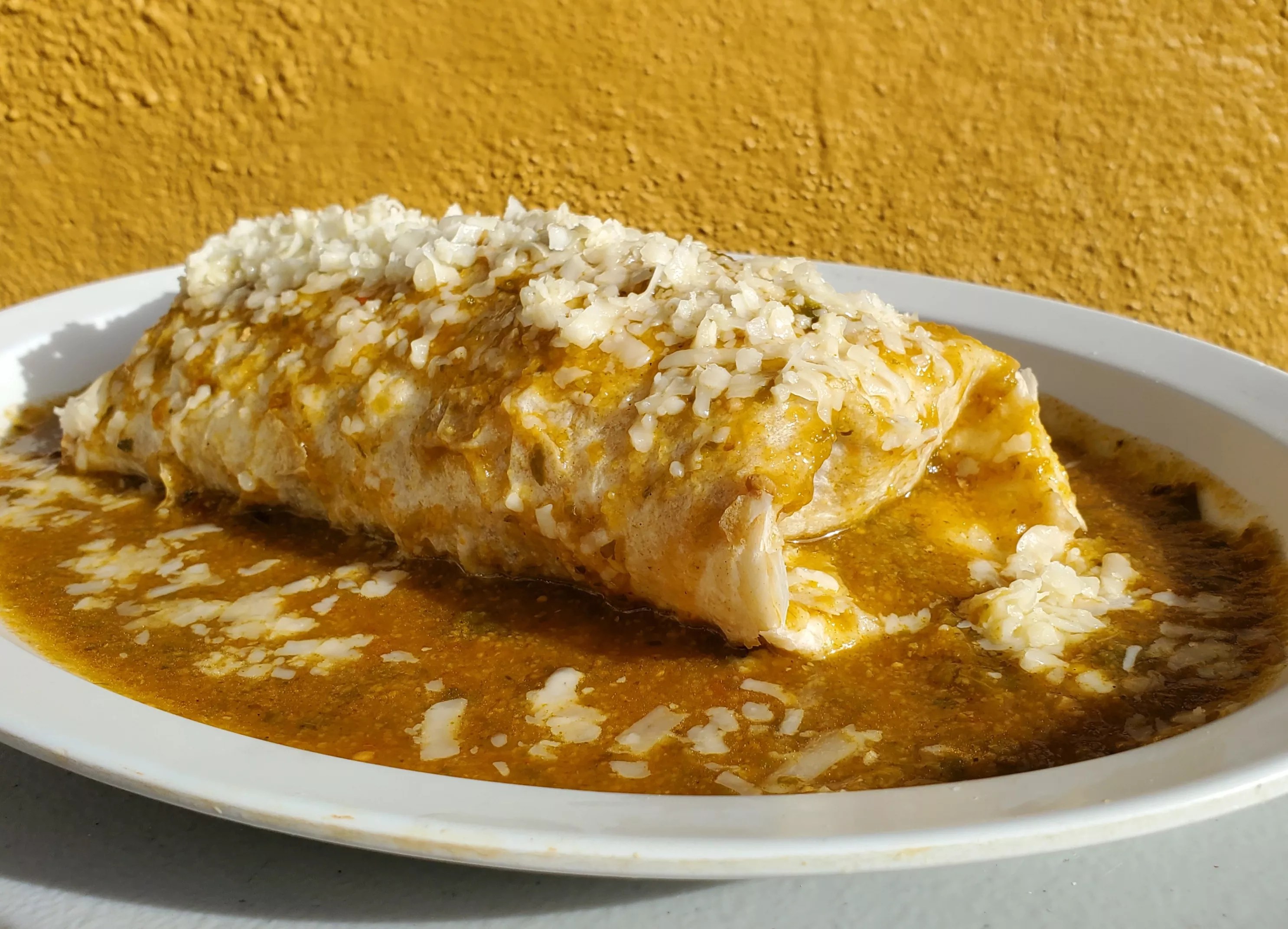
El Taco de Mexico has perfected smothered burritos.
Molly Martin
Reilly: El Taco de Mexico, 240 Union, Esters, Root Down, Guard and Grace, Los Dos Potrillos, Rootstalk.
Mary Nguyen, chef/owner, Olive & Finch: Restaurants that really show off Colorado cuisine are all about using fresh, local ingredients and keeping things creative. The Wolf’s Tailor mixes local produce with global techniques, giving you a taste of both Colorado and the world. Blackbelly in Boulder is another standout – it sources locally and even has its own butchery, so you know everything’s top quality. For an Asian twist, Uncle is awesome – it uses local ingredients to make its ramen and other dishes feel uniquely Colorado.
Erasmo Casiano, chef/owner, Lucina and Xiquita: Tocabe does a great job at representing the Native communities of Colorado while restaurants like Annette do Colorado produce justice at every turn of the season. Also, with farms like Esoterra providing fantastic produce and natural practices to restaurants, I think it’s never been more important to appreciate the love and effort and the people behind every dish. Places like Sap Sua, Alma Fonda Fina, MAKFam, Yuan Wonton, Olivia, Annette, Ni Tuyo, Thank Sool Pocha and our friends at Rootstalk and Bin 707 really show just how diverse and delicious the Colorado dining scene can be, all while raising the standard.
Lucero: There are so many restaurants that we identified as Colorado classics over the years for one reason or another – Bastien’s, Casa Bonita, My Brother’s Bar, Santiago’s, Buckhorn Exchange, Ajax. Currently, there are probably too many to list that are really doing a great job representing what Colorado has to offer on their menus. I think chefs like Alex Seidel, Kelly Whitaker and Hosea Rosenberg really took things to the next level and helped us all have more access to what is being produced here. There are so many great restaurants that may be defined as French or Italian or American but are still utilizing and finding great value in supporting our local producers.
Rodriguez: When I think about this one, I think about the restaurants that most often represent Colorado or that represent that focus on working with local growers and producers. A few of many examples would be Casa Bonita as a cultural landmark; El Taco de Mexico (especially when you talk about green chile); Root Down, Fruition and Rioja for leading the focus on local ingredients; and Buckhorn Exchange, because of the longtime commitment to Colorado game.
Osaka: I think the Fort is a good representation of Colorado cuisine, from its Game Plate to Rocky Mountain oysters. Tocabe is another one that represents American Indian cuisine, sourced from Native and Indigenous producers.
Davis: It doesn’t get any more Colorado than Buckhorn Exchange.
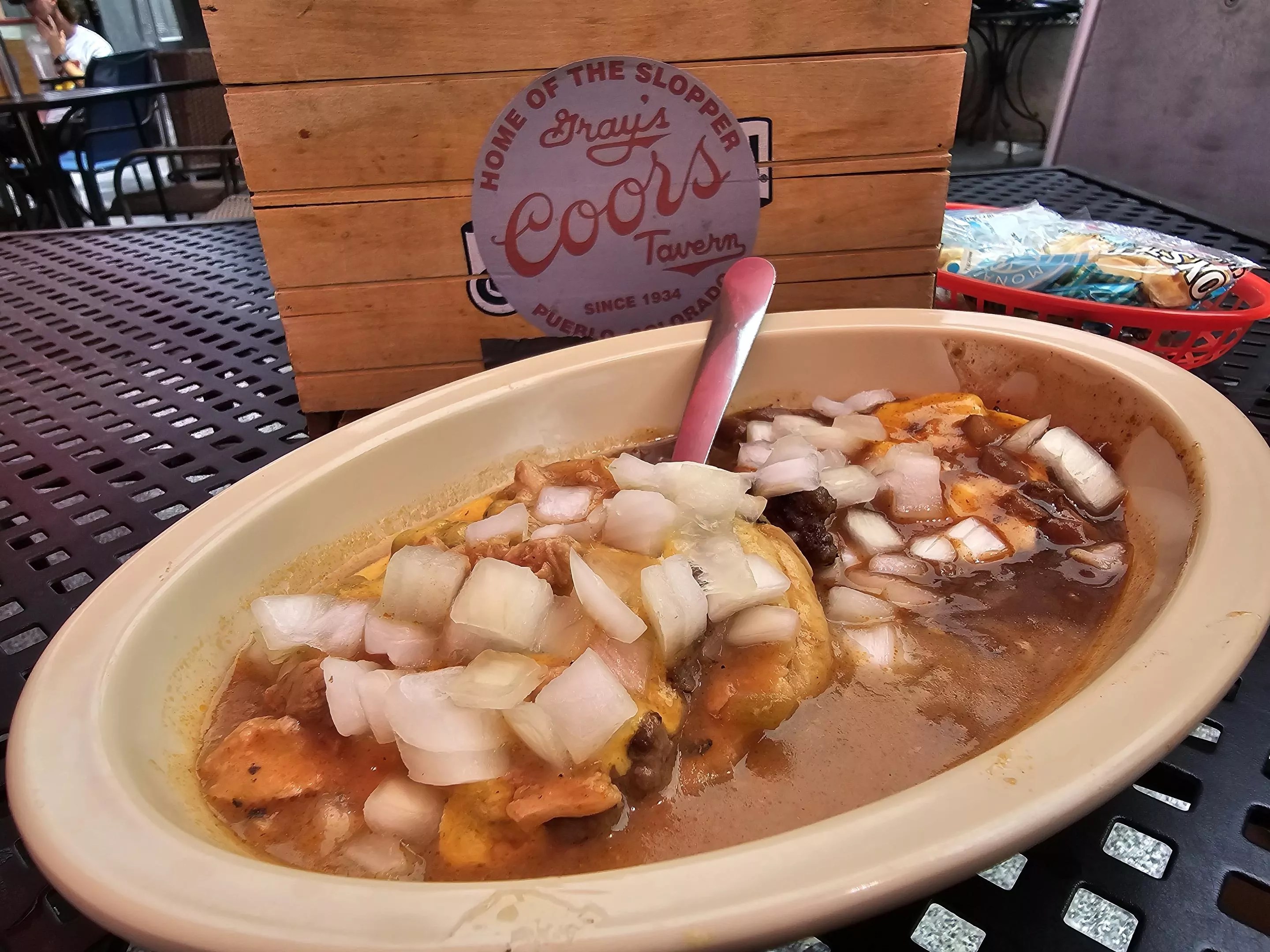
A classic Pueblo slopper.
Molly Martin
What dishes (either specific ones from restaurants or general categories) are a key part of Colorado cuisine?
Porytko: I know Rocky Mountain oysters seem like an obvious choice, but they’re always fried to oblivion so I’m not gonna count them. If I’m gonna eat a testicle, I want to know the experience of eating a testicle – otherwise, what’s the point?
Mendenhall: The Slopper (born in Pueblo), cinnamon rolls (Johnson’s Corner), Rocky Mountain oysters, the sugar steak at Bastien’s.
Bonanno: You know what speaks to me of comfort food that’s uniquely Colorado? The almond flour pancakes at Root Down, a latte in a giant mug from Pablo’s, the spicy la zi ji from Hop Alley or tongue tacos at El Taco de Mexico.
Caroline Glover, chef/owner, Annette and Traveling Mercies: I drive down East Colfax every single day to get to Annette and Traveling Mercies (I call it the Colfax crawl!), and some of my favorite haunts that have been around for decades are Tacos Acapulco (for the pupusas!) and La Costera for the best grilled chicken. These dishes are absolutely a key part of my Colorado cuisine.
Imbergamo: I’m not sure they’re indicative of “Colorado cuisine,” but the chile relleno burrito at El Taco de Mexico. Pho in any number of places, but especially along Federal. Anything Jen Jasinski makes with Colorado lamb. The Pueblo slopper. A giant steak and martini at Elway’s.
Antonation: Colorado’s green chile is kind of a secret outside the state, since it’s usually associated with New Mexico. But Colorado’s thick, gravy-like green chile can be found at nearly every bar and grill, as well as at longstanding Mexican restaurants. Colorado also has a few distinct Italian/Mexican hybrids, like Denver-style cannoli made with spicy sausage and a strip of green chile, or sausage sandwiches in Pueblo also made with green chile. In Denver diners, look for Greek/Mexican mashups like gyros or souvlaki breakfast burritos.
Reilly: The handheld breakfast burrito is the Colorado dish. Closed book.

A dish by chef Jennifer Jasinski: Colorado lamb, Olathe corn polenta, Palisade peaches and charred Jimmy Nardello peppers.
Courtesy of John Imbergamo
What ingredients play a key role in Colorado cuisine?
Porytko: Local seasonal ones like cherries, Olathe corn, Palisade peaches (maybe the world’s greatest fruit), melons, tomatoes, incredible local lamb and, of course, Pueblo chiles.
Silva: We often talk about Colorado’s Pueblo chiles – which have certainly earned their top spot, and I love seeing the whole culture around roasting them in the fall. But behind that main star are so many other chiles bringing the heat: Anaheims, jalapeños, habaneros. I even found fresh chile piquín recently, a favorite of mine from Monterrey. In our house, a simple summer staple meal is grilled ribeyes on our fire pit with fresh tortillas and salsas blending the heat of Colorado chiles with juicy garden tomatoes in the molcajete. It doesn’t get any better.
Imbergamo: I would include the obvious ones: green chile, Colorado lamb, Olathe sweet corn, Palisade peaches, craft beer, artisan whiskey. I might add Colorado heritage/heirloom grains that supply the local distillers and brewers. For example, Laws Whiskey uses grains grown with love at Cody Family Farm in the San Luis Valley and the Whiskey Sisters Supply out on Colorado’s eastern plains. In the ’80s, this question would have included fresh rainbow trout like the ones from Frontier Trout Ranch in the San Luis Valley.
Mazzocco: Green chiles, lamb, bison, elk and venison. Palisade peaches, greens, pole beans, Olathe corn and mushrooms. There is such an abundance of great farms to choose from that it really makes it quite easy to design seasonal menus. We also tend to see a lot of honey and cheeses, which give us a whole other set of tools to work with when we are keeping a menu local.
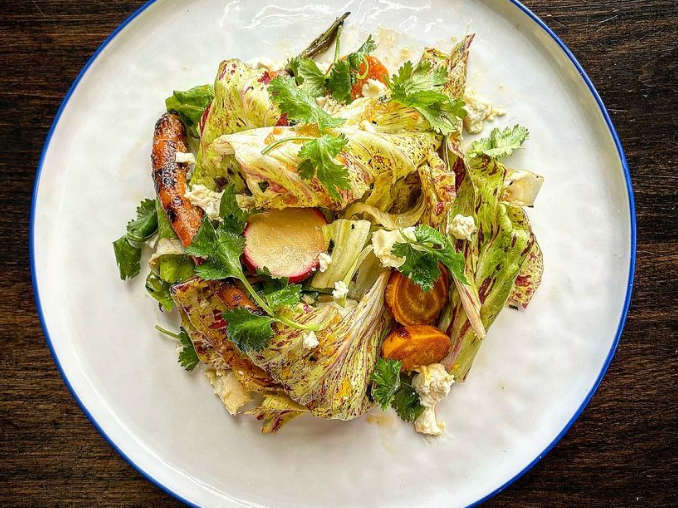
Seasonal vegetables are often the star at restaurants like Annette.
Annette
Glover: It really depends on what season we are talking about. I’ve found that Colorado has some of the best stone fruit that, dare I say, rivals California. From apricots to plums to nectarines, I truly think we have some of the best fruit.
Villalobos: Corn is a staple ingredient that holds deep cultural significance and flavor. I love incorporating it into my cooking, especially through locally sourced tortillas from Raquelitas. Their fresh tortillas elevate my dishes, providing an authentic taste and texture that truly celebrates Colorado’s culinary heritage. Whether used in tacos or enchiladas, the quality of the corn shines through, making every bite a delightful experience.
Anna Nguyen, chef/co-owner, Sap Sua: Local ingredients in Colorado shine so well – any restaurant using Esoterra Farms or Buckner Ranch is a prime example of Colorado produce and livestock at its finest. However, now we see an increasing importance in using foreign products, like heritage corn out of Mexico as well as fish sauce and noodles out of Southeast Asia.
Rodriguez: Now there are so many more than there used to be, and it’s exciting because it means more possibilities to talk about what it means to be Colorado cuisine. There’s Colorado lamb, Alamosa striped bass, trout, green chiles, Palisade peaches, bison, elk, mushrooms from foragers and even more and more honey from an increasing number of beekeepers.
Osaka: There’s the usual suspects – Rocky Ford melons, Palisade peaches, Olathe corn – but it’s Pueblo chiles that I think stands out. You’ll find green chile on menus all over the state. I love the friendly battle we have with New Mexico and Hatch green chiles; it’s all in good fun.
Bonanno: Curiosity.